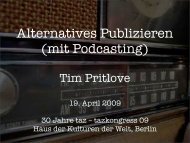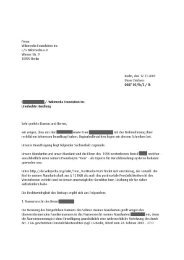Proceedings
Proceedings
Proceedings
Create successful ePaper yourself
Turn your PDF publications into a flip-book with our unique Google optimized e-Paper software.
| 232<br />
Figure 2: Simple correlation with logical conjunction<br />
- failed<br />
Assuming that the whole process would take 10<br />
seconds a matching rule can be constructed. It<br />
would consist of a logical AND-conjunction of the<br />
event ”ICMP Ping”, ”Buffer Overflow” and ”File<br />
Change”.<br />
As shown on Figure 1 that would work fine for<br />
the exact order of events within the expected time<br />
window. The big flaw would be exposed if one of<br />
the events runs a little bit out of the time window<br />
(Figure 2). Even when the behaviour of a worm<br />
is well-known and carefully described in the rule,<br />
divergences can happen as a result of load differences<br />
or network latency. As the rule uses logical<br />
conjunctions there are only the states ”true”<br />
and ”false”. If one event is missed, the whole rule<br />
would lead to a sharp, wrong decision - in this case<br />
”false” which means the system would not detect<br />
the attack.<br />
To avoid short wrong decisions a fine grained<br />
rating system must be introduced. A look at<br />
modern cybernetics opens a promising prospect<br />
to fuzzy logic which allows to utilise such a fine<br />
grained rating.<br />
5.2 Fuzzy technologies<br />
Fuzzy technologies were often associated with the<br />
term fuzzy logic 14 which is the most popular application<br />
for them. The basic principles of fuzzy<br />
logic are the set theory and the logic. The set<br />
theory deals with the conjunction of sets and the<br />
logic deals with the conjunction of conclusions. A<br />
special form of the logic is the Boolean algebra.<br />
14 http://en.wikipedia.org/wiki/Fuzzy logic<br />
5<br />
Figure 3: Events with assigned affiliation functions<br />
Conclusions in Boolean algebra can only adopt<br />
two states - either true or false. The same applies<br />
on the resulting set which can be described<br />
by a two-valued affiliation function.<br />
To achieve a smooth transition instead of using<br />
only two states the two-valued affiliation function<br />
has to be replaced by a continuous one. This function<br />
builds the foundation for the so called fuzzy<br />
set. A fuzzy set is defined by the ordered pair<br />
(X, μM). X represents the basic set and μM is<br />
the continuous affiliation function. The affiliation<br />
function maps the set X to the interval [0, 1] and<br />
shows how much the resulting value belongs to the<br />
fuzzy set.<br />
5.3 Applying fuzzy technologies to IDSs<br />
Goal of using fuzzy technologies in IDSs is to provide<br />
a facility to program smooth rule sets for unsharp<br />
detection of related events.<br />
Therefore every type of event which is expected<br />
to be related to a certain incident will be assigned<br />
to an affiliation function. As the events are lined<br />
up on some kindoftime bar the value of the function<br />
at the particular time stamp where it occurs<br />
expresses how much the event belongs to the supposed<br />
incident.<br />
Employable affiliation functions have a definition<br />
range in between the real numbers and a value<br />
range in the interval [0, 1]. A few examples you<br />
can see in Figure 4.<br />
The practical proceedings are quite different<br />
from the formerly introduced logical conjunction<br />
based approach. Since values of the affiliation






